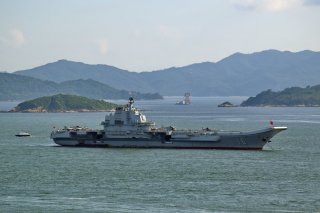Does China’s Carrier Strike Group Have a Stalker?
Chinese news sources have accused the U.S. Navy of behaving in a provocative way.
The People’s Liberation Army-Navy has sent its first indigenous carrier on deployment in the South China Sea along with something resembling a carrier strike group. This move immediately follows the deployment of China’s first carrier to the region.
The Shandong, the first Chinese-built carrier, has been operational for a while and has been deployed on a sphere of missions in the region, including the South China Sea. The move might not seem surprising in light of a recent Chinese news report accusing a U.S. destroyer of “stalking” its Liaoning carrier group. While the Chinese claim the U.S. destroyer was “risking an accident” and behaving in a provocative way, the U.S. Navy very routinely operates destroyers, carriers, and even amphibious assault ships on patrol in the Pacific to ensure stability and conduct exercises and war preparations as needed. As part of this overall strategy, the U.S. Navy also conducts Freedom of Navigation exercises to establish its ability to sail wherever international law allows. These initiatives are also, in part, designed to challenge what the U.S. and its allies regard as illegitimate territorial claims in the South China Sea.
The Chinese-government backed Global Times newspaper described the Shandong as part of a group that could practice coordinating with other vessels including destroyers and frigates like in real combat, instead of acting alone and testing its own technical parameters like during trial phases. This is the first time in 2021 that the Shandong has embarked on exercises of which the general public has been informed.
While in service since 2019, the Shandong has participated in dual-carrier operations with China’s Liaoning, combat drills which took place not long after the U.S. Navy operated combat-training sorties with two carriers together in the Pacific.
China’s deployment with the Shandong is not likely to surprise or greatly concern Pentagon planners and strategists, as it is by no means unusual or particularly alarming. However, operating several carriers in rapid succession in this capacity, and flanking a carrier platform with surrounding warships, much like U.S. Navy Carrier Strike Groups, looks like a dynamic that could get the attention of the Pentagon.
The Chinese paper made a point to emphasize China's power projection and strike capabilities evidenced by the rapid emergence of a second carrier, making the claim that China has two carriers ready for war at any given time.
Yet another element of the Chinese newspaper story emphasizes a Chinese claim that the two PLA-Navy carriers will be adding more “long-distance voyages,” in a clear reference to China’s well-known ambition to dominate the global arena in coming years with massively increased power projection ability.
However, despite having more actual numbers of “ships” than the U.S. at the moment, China still has a long way to go before it could come anywhere near an ability to truly rival the U.S. Navy’s 10-carrier fleet when it comes to global power projection.
Kris Osborn is the defense editor for the National Interest. Osborn previously served at the Pentagon as a Highly Qualified Expert with the Office of the Assistant Secretary of the Army—Acquisition, Logistics & Technology. Osborn has also worked as an anchor and on-air military specialist at national TV networks. He has appeared as a guest military expert on Fox News, MSNBC, The Military Channel, and The History Channel. He also has a master’s degree in Comparative Literature from Columbia University.
Image: Wikimedia Commons

